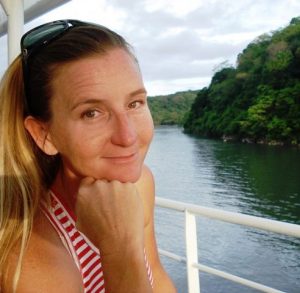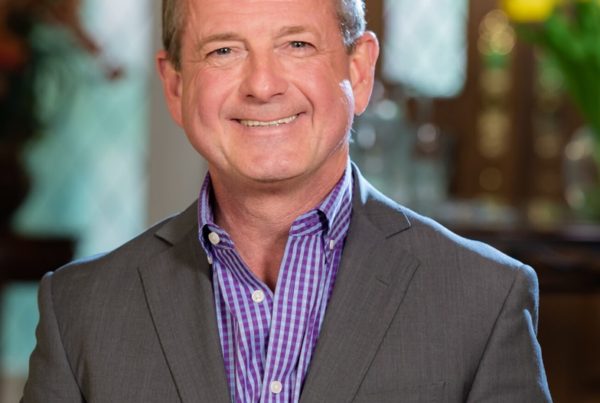Podcast: Play in new window | Download
Subscribe: RSS
Why is tree planting in the rainforest particularly important and how can we do it better?

Jennifer Smith “Tree Jenny”
Founder of Community Carbon Trees, Jennifer Smith has devoted over 17 years to planting and growing more than 556,000 trees in Costa Rica. Born in Southwest Louisiana, she was raised on a sustainable family farm where she learned the importance of land stewardship and sustainable business practices from a young age.
She earned a Juris Doctorate degree at Louisiana State University in 1993 and in 2000, went to Costa Rica to embark on a mission to plant trees. Her work to build community, protect biodiversity, and reverse climate change is a model for how all people can coexist with nature.
In addition to her expertise in tree planting and reforestation, Jennifer also became a Certified Auditor of carbon dioxide under international guidelines. Jennifer is trained to calculate carbon footprints to determine baselines for sequestering CO2. In addition, Jennifer completed the agroforestry calculations to determine how much CO2 is sequestered by tropical trees using accepted techniques and practices.
Jenny provides private consulting services to help individuals and businesses understand their carbon footprint. She can determine how many trees you need to grow over 25 years to offset your CO2 footprint and become carbon neutral.
In this conversation with us, “Tree Jenny” as she is known within the tree planting community, shares what ignited her passion for tree planting and reforestation of the rainforest and why it’s something that we all need to be supporting.
Side-stepping the blame game, Jennifer emphasizes the importance of focusing our attention on the solution. She explains the role that tropical trees play in rain patterns and climate change around the world, and why conserving existing forests – or simply planting millions of trees – is not enough.
Her approach to planting trees and growing biodiverse forests over the long-term also includes helping local farmers and workers regain their self-esteem and purpose and work together as a community, thus ensuring sustainability and scalability.
What We Discuss With Jennifer Smith, a.k.a. “Tree Jenny”
- Why planting trees near the equator is more effective than in other parts of the world
- What goes into long-term sustainable reforestation programs
- The effects of reforestation on the local community
- How much tree planting and regrowth costs in the rainforest
- The power of biodiversity in the rainforest
Key Takeaways
Who inspired you to start this movement?
I started by doing private reforestation for individuals who came to Costa Rica and bought land. At some point I realized that it would be more rewarding to do the same work with Costa Ricans who really didn’t have any money or resources other than dead cattle land.
We had a lot of workers with us who were expressing interest in receiving the trees we were producing on these foreign owned farms, so it was very organic and a natural step by step process.
It planted the idea in my head that we need to be creating jobs, creating a relationship while regrowing the rainforest instead of fighting about people cutting it down.
I learned before starting the organization that most of the reason that local people cut down the rainforest was poverty. Now the foreigners are doing it for real estate development.
We asked, “How do we help local people to hang onto their land, fall in love with their land, and repair and regenerate their land so they could actually make a living off of it?”
Everything lined up and in 2009 I was inspired by Barak Obama who did one of the first crowdsourcing campaigns on the planet. A friend told me that he had raised millions of dollars just by people giving $20.
So I figured out how to get a Paypal account. We had a very simple but very informative first website, and we got our first decent sized donation of $1000 from a man in Norway who thought what we were doing was amazing. He loved that we paid the workers and followed up on every tree.
It started one tree at a time, with friends and family, seeing a problem and trying to create an innovative solution and 11 years later here we are.
We continue to expand and grow and continue to hold our ethics to a high standard of tree care and fair pay for our workers.
We are not the cheap tree growers. We are not the ‘buy a hat and get a tree’. We are a long term forest growing organization. The work only starts with tree planting.
What is happening there in terms of reforestation of the rainforest?
It’s a deep question that has now been coined climate justice. Most of the people suffering from climate change are poor people who don’t have the money or resources to adapt. That’s why the fair pay part of our model is so different than a lot of tree planting organizations.
We have been imitated and copied since we went online in 2009. I know we were one of the first. There weren’t any ‘sponsor a tree’ programs back then.
Now so many people I’ve had conversations with, even some who have come to Costa Rica to meet me have created their own tree planting projects that have far exceeded us on the fundraising level but I don’t know if they’ll exceed us on the forest growing level.
Survival rates depend on follow up management. Not only are we paying people to do the work – from collecting the seed, making the compost with women for the tree nurseries, transplanting and working in these nurseries.
The trees need about a year and a half before we can plant them, and then the transport and preparation of the land, and then 4-6 years of follow up – chopping grasses, making sure the trees don’t choke in the regrowing cattle grasses and the regenerating vegetation.
I have not met many groups doing the follow up, ensuring that every tree planted is actually growing.
Even in Costa Rica, the government gives away a lot of trees but nobody is getting paid. I’ve seen Costa Ricans get 100 free trees and two years later those 100 trees are sitting by the porch dried up and dead.
It’s really hard work to chop the cattle grasses and get the trees to grow. It’s itchy, scratchy, hot, and dangerous because there are snakes.
Being a lawyer it was really important for me to look at that, dare I call it slavery – taking advantage of very poor people.
The trees are so beautiful and everyone loves trees, so people say that they’ll get to have the fruit of the trees one day as their pay. That doesn’t feel right to me.
There are no standards in our industry. The tree planting industry is totally non-regulated and it’s allowed a lot of marketers to come in, get a million people to donate a dollar each and feel really good about themselves. But I haven’t seen the proof of the forest.
It’s much more expensive to produce big fat trees that are going to survive in the tropics. It’s much more expensive to produce 125 different kinds of trees rather than buying 500 bags of seeds of all the same tree and grow some tiny trees.
It used to bother me a lot because we work hard and I know what we do works, until I recognized it was depleting me and I was in a negative vortex about it. Instead, it is about the solution and championing the multi-level stacking functions of the solution.
People are going to protect a forest that they’ve gotten paid to grow. There’s accountability and self-esteem, and pride with it. The Costa Ricans love what we’re doing and they’re really proud of their growing forest.
That forest is full of products and things that they can sell, so they can eat and barter. They get off the pesticides and herbicides. Dried up streams and water springs start to relive and bubble again.
It really is regenerative. Not just the agriculture but the community. People start to talk to each other, and they start to care about what’s happening on each other’s neighboring farms. They begin to report when someone is using herbicides and they take it upon themselves to tell them that they don’t want that going into their water source.
Why are the tropics the best place to grow trees?
Trees within 10 degrees of the equator in the tropics are sequestering compounded amounts of carbon dioxide. The reason is that we never have a cold season, so the trees grow much bigger, harder and faster. The amount of carbon dioxide sequestered depends on the size of the tree and the density.
We’re growing really hard tropical lumber along with all kinds of fruit.
Because we have a really hot intense dry season, even the fruit trees grow very dense. When factored into the carbon equation the density multiplied by the size and number of years growing, they blow away any trees grown in a temperate environment.
Then we look at the water cycle which is as big a problem facing humanity right now as the carbon, and it dovetails in.
We have double the amount of water vapor in our atmosphere than we historically have ever had, and water vapor is a greenhouse gas.
The trees in Costa Rican where it rains so much are making cool, cumulus, fluffy clouds that go into these spiraling currents that wrap around our planet.
So we can solve the broken half hydrological cycle by returning the tree into the cycle, slowing down the evo-transferation and making sure that what’s getting in those currents are getting all the way around the planet to places like Kenya and Syria that over the past several years have completely dried out.
We care about the water, we cannot live without it, and the RAINforest is really driving that water cycle both from a cooling aspect and getting some of that extra water vapor out of the air, and also in the rain aspect.
Also, if we don’t reforest, if we leave these pastures bare, they turn into a hot skillet. When water hits a hot skillet, it skittles up and that’s the extra water vapor that’s in our greenhouse gas mix.
So we’re accomplishing 5-6 very important things with the hydrological cycle simply by working on the equator.
We need to act locally and act globally. We have to do both. We can’t just say, I’m going to plant trees in my backyard and that’s good. That’s great and it’s going to work your local micro ecosystem but if the rainforest trees are not there, the trees in your backyard may not get enough rain; it may get too hot or too cold. The extremes of temperature are also part of what is happening.
That’s what we’re doing with our movement. We’re giving people a place to act globally.
How is your Community Carbon Trees movement structured?
We wanted to give people a way to volunteer. People ask if they can come and plant trees. We say no, we want to create jobs. But we do want participation which is the juice of life.
One way is though helping us get our message out there – through podcasts, writing articles, sharing on social media.
Another way is our Tree Ambassador program. These are people who take our message and make it their own. They do fundraisers, social media campaigns, and work through their own networks and businesses in terms of giving back a percentage of revenue.
We allow them to put our logo on their products, give them whatever information for their catalogues, and some them have us calculate a carbon footprint for them or their product.
They love it and feel like they are doing their part. People want that. They don’t just want to give money.
When people do come to Costa Rica we offer service days in our tree nurseries. That’s where they can get their hands dirty, make compost, plant baby trees, weed, rotate trees and collect trees.
We find that if someone does a tour with us or comes to the nursery, they learn so much and then give trees to people for Christmas, and become a Tree Ambassador.
So we like to meet the people we just don’t want to throw them into a job where they don’t have the experience.
How many trees need to be planted in order to replace what has been lost?
I think it’s about 13 trillion. But they have to be planted and grown (into full size trees).
Without good follow up, I’ve seen the losses and it’s up to 80%. However with good maintenance over a 25 year cycle, 85-90% of trees live.
Over the first 4 years we replace every tree that dies. At year 6 we prune, which helps the trees keep getting bigger. When the canopy closes and the trees start touching each other, then we open some light and cut some of the lower branches, so the trees can keep getting bigger.
I’ve seen monoculture (one kind of tree) literally stop growing around 12 years old – everything starts to die. Every kind of tree has a different root structure. So if you’re only planting one kind of tree, they’re all sucking the nutrients out of one level of the underground and completely depleting all the nutrients so they start to die.
So we have to do this 13 trillion tree thing right otherwise what’s the point? Who are we fooling? I feel like there are good intentions with all these tree planting people, but let’s do it right.
How much does it cost to plant and grow a tree?
We ask for $25 per tree. That covers the seed, meeting with the farmers, nursery work, women’s compost movement, childhood and youth education, the 4 years of management, the 6th year chop, insurance for all the workers, and fair pay for every hour that people work. After the 6 year point, we have a yearly meeting with farmers, and we go out if they need help, doing an estimate, if there’s loss.
There’s not a huge admin cost in there, it’s not even 6%. There’s also not a big marketing budget in there. We really let the marketing happen just as you and I are doing right now. That’s where the volunteering comes in.
If you received a large lump sum of money would you be able to scale?
We’ve been planning for this success. One thing we’re about to complete are our manuals that break the work down into pods and each pod has a leader – the tree planters, the farm owners, the women’s group that does seed collection and composting, the administrative pod that includes our accountants, the ACCT, the agriforesters, and the local community leaders.
We have people who are ready to take on more work when we have more money. I think the time has come. We’re ready to scale, holding to our high standard, insisting on fair pay, biodiversity, having women included, and honoring the farm owners by empowering them to keep their land rather than buying their land.
We’ve practiced with a lot of people, and like to keep it simple; lean management and lean administration, and by teaching these local people the process so that they’re managing themselves. It goes back to self-esteem, pride, self-care, and neighborhood vigilance.
We can feel very secure that they’re not going to cut their trees down. We have them sign a contract with an enforcement provision. Besides, there are eyes everywhere in the community watching.
The only reason why they cut the trees down in the 1970s is because they were subsidized. They didn’t even make things out of the lumber. They simply burned it because the land was so steep there was no ways to get the trees off the land, nowhere to mill them, and no markets. The government simply said, “We got some foreign money to grow cattle so we’re going to pay you to burn your forests down.”
What they didn’t realize is that rainforest soil is thick and deep. A couple of years of heavy rain alternating with burning sun, and that top soil is gone.
So they have these genetically modified cattle grasses, and trees can’t get through there.
Once you start shading the genetically modified grasses (meant for the hot sun) with the trees we’re growing – we cut a circle around the trees for the first 4 years – they start to die and the hidden jewel plants and seeds that have been dormant begin to activate with the lower temperatures.
The soil begins to absorb the water, and the trees begin to drop biomass, and we start having birds come and animals. Their urine has urea which fertilizes the fungus, etc.
The soil becomes soft and fertile again, and it looks like someone came in and landscaped. Things we didn’t plant come back once the trees got big enough to offer some shade and get these cattle grasses out.
It’s a lot of patience and a lot of work to get to that stage but about in 4-5 years, it’s unbelievable how the trees regenerate. We can do this!
99% of the land is owned by the wealthy. For the 1% who still own land, I think it’s important that they continue to own that land. They grow our food.
Disenfranchised people change. They move to the city, and they’ve never lived in the city. Some become alcoholics and completely lose their vibe. So it’s important that we do this with the local people.
Episode Resources
Environmental Problems and Solutions
Connect With Tree Jenny and Her Team
- Website: Communitycarbontrees.org
- Facebook: https://www.facebook.com/communitycarbontrees
- Instagram: https://www.instagram.com/communitycarbontreescostarica
- Instagram: https://www.instagram.com/treejenny
Listen on Apple Podcasts, Spotify, Pandora or Stitcher.
Did You Enjoy The Podcast?
If you like this episode let us know! Reviews for the podcast on iTunes are greatly appreciated. This helps us reach more entrepreneurs seeking to make a positive impact in the world. If you received value from this episode, it would mean so much if you could take a moment and leave your 5-star rating and review. You can do that by visiting here. Thank you! Together we can make a difference!










